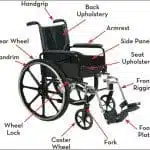Wheelchair Spring Cleaning
Posted in Inspecting and cleaning your wheelchair
General Maintenance and Cleaning Tasks for Your Wheelchair
With May fast approaching, many New Yorkers are taking the opportunity to do a little spring cleaning after the long winter months. In keeping with the spirit of the season, the team at SelectCare Home Care Services of NY thought now would be a great time to discuss a spring cleaning task that is all too often overlooked: wheelchairs!
The slushy, salty winter months can take a serious toll on wheelchairs, and regular maintenance is key to ensuring these important tools continue to serve their owners well. In this blog, you will find a step-by-step guide to general maintenance and cleaning tasks that will have your wheelchair rolling smooth and looking factory fresh.
Pre-cleaning Inspection
- Before cleaning, be sure to inspect your manual wheelchair’s frame for cracks in the metal. A cracked frame could lead to larger problems down the line and should be immediately reported and replaced.
- Check that all nuts and bolts on your chair are tightly screwed together, and tighten any loose bolts. Note the bolt that holds together the folding cross braces below your seat is intentionally left loose to allow for folding.
- If your wheelchair has any points that fold, pivot or should be removable, be sure that these pieces do so easily. To fix any moving parts that are stuck in place, silicone-based lubricants like WD-40 can be applied. If you try this and still cannot move the piece, it is recommended you contact your wheelchair dealer or technician for assistance.
- Inspect your seat and armrest cushions for cracks, tears or other upholstery damage. Also check your seat cushion to ensure it still provides the padding you need, as many cushions will go flat over time. Prolonged exposure to any metal parts pointing through the cushion or seat upholstery can cause pressure sores over time.
- Finally, check the chairs brake system to ensure the lever easily slides from locked to unlock without excessive force. When checking the brake be sure that it fully engages the tire when braked and lets it roll freely when left off.
Tire and wheel care
- Be sure to check your wheelchairs tire pressure (if applicable), either with a pressure gauge or by hooking the tire up to a standard bicycle pump. Make sure the tire pressure matches the rating printed on the side of your tire. DO NOT use a gas station tire pump, as these are meant for much higher-pressure car tires and can lead to over inflation and flats.
- Check your tire treads for wear, cracks or tears. Worn down treads can cause poor traction and braking, while damaged tire treads can lead to unexpected flats for inflatable tires. Inspect both tires for broken glass and other debris, which should be picked out of the tire regularly to avoid unnecessary damage.
- Check the chairs smaller front wheels (casters) for any cracks or other damage. If you notice damage, even if it is a small chip, have the caster replaced to avoid potential flipping.
- Difficulty turning or a side-to-side “flutter” while moving forward is a sign the chairs caster nuts must be adjusted. Either loosen the nut to allow easier turning or tighten to prevent caster-flutter.
- Turn the chair upside and spin all four wheels. Hair, string and other foreign objects will oftentimes work their way into the bearing at the center of each wheel, causing wheels to spin more slowly and make the chairs user work harder. If a wheel spins slowly or needs more force to move, try using a pick or other small metal object to pry objects out of the wheel.
- Finally, check your wheelchair’s wheel alignment by doing the following: Glide the chair (without an occupant) several feet. If the chair pulls to either side, you may need to contact your wheelchair dealer or technician for assistance aligning the wheels properly.
Cleaning
- Cleaning accumulated grit from the underside of a wheelchair (especially after the long winter months) can get a little dirty. Be sure to wear protective gloves and thoroughly wash your hands after cleaning.
- To clean the majority of dirt and grit from a wheelchair, start with a dry cloth or paper towel to remove and large chunks of accumulated dirt. After this initial pass, simply use a rag or sponge soaked in mild detergent (like dish soap) and warm water to clean the chair’s frame.
- When cleaning with soap and water, be sure to focus on parts of the chair you most commonly touch, like the chair’s handles, armrests and hand rims to avoid unnecessary exposure to germs.
- Some manufacturers recommend using Armor-All or similar car care products on wheels and casters. Be sure to follow the manufacturer’s instructions when using these products. After applying cleaning products to the tires, it is recommended you let these substances dry before using the chair, otherwise you might leave dirty tire marks on floors and rugs.
Inspecting and cleaning your wheelchair thoroughly for the first time can be a bit time consuming, but with practice and regular cleanings, you will find the process takes as little as 20 minutes to half an hour.
If you or a loved one experience limited mobility, have concerns about the state of your assistive devices, or just need an extra helping hand around the house, the staff of SelectCare Home Care Services of NY is here to help. Our team of home health care experts has more than 30 years of experience helping New York families overcome challenges large and small. To learn more, call SelectCare or request a free home health care guide today.
